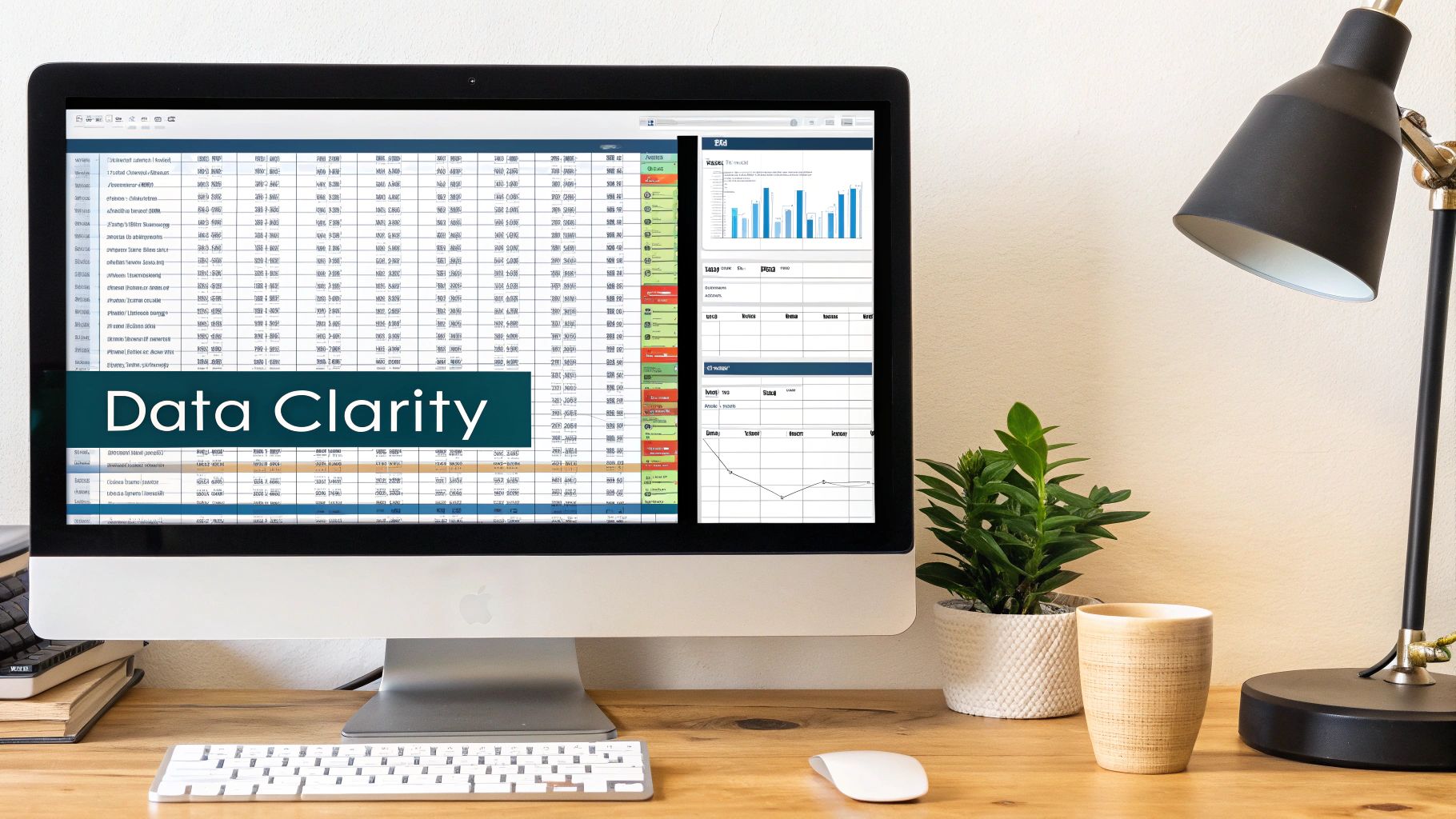Why Your Business Is Leaving Money on the Table
Many UK businesses rely on intuition instead of hard data for crucial product decisions. This can lead to missed opportunities and lost revenue. This section explores how a product profitability analysis template can shift your business from guesswork to informed, strategic decision-making. This shift reveals your top performers and the products draining your resources.
Imagine two seemingly successful products. One generates high revenue, but hidden costs result in a low-profit margin. The other has lower sales but significantly higher profitability. Without proper analysis, you might invest in the wrong product, hindering your growth. This is where the power of product profitability analysis comes in. It's a crucial tool for UK businesses, enabling them to evaluate the financial performance of individual products and maximize profits.
For example, a UK coffeehouse chain could use this analysis to identify its most profitable products, optimizing their offerings and pricing strategies. By analyzing revenue contributions and cost structures for each product category, companies can streamline operations and boost profitability. Want to learn more? Learn more about product profitability analysis.
The Real-World Impact of Operating Without Clarity
Conversations with financial directors and business owners across the UK reveal the tangible consequences of not understanding product profitability. These consequences range from missed growth opportunities due to misallocated resources to the erosion of profit margins caused by underperforming products.
This lack of clarity often leads to reactive, not proactive, strategies, leaving businesses vulnerable to market fluctuations and competitor advancements. Companies that embrace data-driven decision-making through a product profitability analysis template, however, gain a significant competitive advantage.
They can strategically invest in their true profit drivers, confidently adjust pricing, and make informed decisions about product development and discontinuation.
Transforming Data Into Action
By understanding the true cost and profit contribution of each product, you can make targeted adjustments that maximize your return on investment. This means confidently allocating resources to high-performing products, potentially boosting their profitability further.
Additionally, understanding which products are underperforming allows you to address the underlying issues. This could be through cost reduction strategies, price adjustments, or even strategic discontinuation.
A product profitability analysis template provides the framework for this data-driven transformation. It empowers you to move beyond gut feelings and make decisions based on concrete evidence, ensuring you're not leaving money on the table. This approach not only increases profitability but also enhances overall business resilience and fosters sustainable growth in the competitive UK market.
Building a Template That Actually Delivers Insights
A basic spreadsheet is a good starting point, but it's only the first step. The true value lies in transforming the data you collect into actionable strategies. To achieve this, you need a product profitability analysis template that goes beyond simple number crunching. This means understanding the complexities of various cost factors, automating important calculations, and adapting the template to the unique needs of your business.
Key Considerations for Template Design
Creating a robust template requires careful planning and consideration. It should account for often-overlooked expenses like indirect costs, such as administrative overhead and marketing spend allocated to each product. Automating calculations like profit margin and break-even point not only saves valuable time but also minimizes the risk of errors.
To ensure your template covers all the bases, here's a checklist of vital components:
- Direct Costs: These include the costs directly related to producing your product, such as materials, labor, and manufacturing overhead.
- Indirect Costs: These are costs that are not directly tied to production, but still contribute to the overall cost of each product. Examples include administrative overhead, marketing, and research and development (R&D).
- Pricing: Your template should accurately reflect your pricing strategy, incorporating any discounts or promotions.
- Sales Volume: Incorporating accurate sales data and accounting for potential seasonal variations is critical for a realistic analysis.
To provide a clearer understanding of these components, let's look at a breakdown in a table format:
Essential Components of a Product Profitability Template
A breakdown of the critical elements needed in any comprehensive product profitability analysis template
| Component | Description | Calculation Method | Business Impact |
|---|---|---|---|
| Direct Costs | Expenses directly tied to product creation (materials, labor, manufacturing overhead). | Sum of all direct material, labor, and manufacturing overhead costs per unit. | Impacts gross profit and product pricing. |
| Indirect Costs | Expenses not directly tied to production but allocated to products (administrative, marketing, R&D). | Percentage or allocation method based on product-specific metrics. | Affects net profit and overall profitability. |
| Pricing | Selling price of the product, considering strategy, discounts, and promotions. | Market research, competitor analysis, cost-plus pricing, value-based pricing. | Directly influences revenue and profit margins. |
| Sales Volume | Number of units sold over a specific period. | Historical sales data, market forecasts, sales projections. | Key driver of total revenue and profitability. |
This table provides a framework for building a robust template that effectively analyzes product profitability. By clearly defining each component, you can ensure that all crucial factors are considered in your analysis.
Customizing Your Template
Why is customization so important? Because a generic, one-size-fits-all approach rarely works. Successful businesses tailor their product profitability analysis templates to their specific industry and market conditions. For example, a UK-based fashion retailer might include factors like return rates and seasonal trends in their analysis. In contrast, a software company might focus on customer acquisition costs and subscription renewal rates. This tailored approach is essential for making informed decisions aligned with broader industry performance. Product profitability analysis in the UK can be further enhanced by considering sector-level profitability data, such as the gross operating surplus, available from the Office for National Statistics (ONS).
Avoiding Over-Complication
While capturing comprehensive data is essential, avoid creating an overly complex template. Too much detail can lead to analysis paralysis, hindering decision-making. Focus on the key performance indicators (KPIs) that directly drive profitability for your business. Understanding where your business is losing money, much like the discussion on insightful data analysis, requires a strong foundation in data analysis. This enables you to pinpoint the most critical data points and track them efficiently. This focused approach allows for clearer insights and empowers quicker, more effective decision-making. Mergoio offers a streamlined solution specifically designed for TikTok shop sellers to manage product profitability, providing a clear and actionable dashboard to monitor key metrics.
Turning Raw Numbers Into Strategic Direction
A well-designed template transforms raw data into a strategic roadmap. It helps visualize the financial performance of each product, uncovering opportunities for improvement.
- Product Development: Pinpoint areas where product enhancements can boost profitability.
- Pricing Optimization: Strategically adjust prices based on cost and market analysis.
- Resource Allocation: Direct resources towards the most profitable products.
By understanding what drives product profitability, you can make strategic decisions that improve your bottom line and strengthen your competitive advantage in the UK market. This is the crucial difference between simply collecting data and actually leveraging it to drive business growth. Using a customized template provides a clear view of your product portfolio’s strengths and weaknesses, empowering you to make strategic decisions that maximize returns.
From Installation To Insight: Making The Template Work

This section offers a practical guide on implementing a product profitability analysis template for your UK business. We'll explore data collection strategies, address common implementation challenges, and ensure your analysis accurately reflects your business performance, providing a clear view of your product portfolio's profitability.
Gathering Accurate Data: The Foundation Of Effective Analysis
Accurate data is essential for reliable analysis. This involves establishing robust systems for tracking revenue and costs. Revenue tracking should be detailed and consistent, capturing sales data at the individual product level. For instance, Mergoio offers a comprehensive dashboard for TikTok Shop sellers, designed to track individual product and SKU performance. This granular data helps pinpoint top performers and identify areas for potential growth.
Cost data collection requires a comprehensive approach, encompassing both direct and indirect costs. Direct costs, such as materials and labor, are generally straightforward to track. However, indirect costs, including administrative overhead and product-specific marketing expenses, can be easily missed. Allocating these shared costs accurately across product lines is vital for an accurate profitability picture.
Overcoming Roadblocks: Ensuring Smooth Implementation
Implementing new systems often presents challenges. Inconsistent record-keeping or resistance to new processes are common obstacles. Addressing these directly is key to successful implementation.
-
Standardize Record-Keeping: Implement uniform procedures for data entry and storage across all departments.
-
Foster Buy-in: Clearly communicate the advantages of the product profitability analysis template to your team, highlighting its positive impact on decision-making and overall business performance.
-
Provide Training: Equip your team with the skills to effectively use the template, through workshops or tailored online tutorials.
Practical Techniques For Accurate Analysis
Several techniques can improve the accuracy and effectiveness of your product profitability analysis:
-
Allocating Shared Resources: Employ a consistent methodology for distributing indirect costs, such as allocation based on sales revenue, production time, or other relevant metrics.
-
Accounting For Seasonal Fluctuations: Adjust your analysis to reflect seasonal changes in sales and costs, particularly important for businesses in sectors like fashion or tourism. This ensures a more accurate yearly profitability overview.
-
Establishing Update Frequencies: Balance the need for current data with available resources. Set a regular update schedule—weekly, monthly, or quarterly—suited to your business needs.
Achieving Immediate Clarity: The Power Of Practical Steps
By focusing on practical steps, you can quickly gain valuable insights into your product portfolio's performance. This allows informed decisions regarding pricing, product development, and resource allocation.
For example, a UK manufacturer might discover that 20% of their products generate 80% of their profit. This knowledge allows them to concentrate resources on these key products for potentially higher profit margins. Conversely, the analysis could highlight underperforming products, prompting investigation into cost reductions or strategic price adjustments.
Ultimately, a properly implemented product profitability analysis template provides a powerful framework for data-driven decisions, enabling UK businesses to maximize returns and thrive in a competitive market.
Turning Numbers Into Action: Decision-Making Framework
A product profitability analysis template is only as good as the decisions it informs. This section explores how to transform the data from your template into a strategic roadmap for your UK business, guiding product development, pricing strategies, and ultimately, profitability. We'll examine the process of turning raw numbers into informed decisions, focusing on benchmarks, market analysis, and stakeholder communication.
Identifying Key Threshold Indicators
Your analysis will reveal key performance indicators (KPIs) that signal the need for strategic adjustments. High-performing products present opportunities to double down on investment. For these products, consider:
- Increasing marketing spend
- Expanding distribution channels
- Exploring product enhancements
However, high revenue doesn't always equate to high profitability. Some products may appear successful on the surface but drain resources due to hidden costs.
This means understanding profit margins, not just revenue, is crucial. A product with lower sales but a significantly higher profit margin might be a better investment target than a high-revenue, low-margin product. Your customized template provides these critical insights.
Restructuring Pricing and Product Discontinuation
Underperforming products require careful consideration. A product profitability analysis template helps identify areas where restructuring pricing can improve profitability. Sometimes, a small price increase on a high-volume product can significantly impact the bottom line.
In other cases, a price decrease could stimulate demand and increase overall profitability. Finally, discontinuing unprofitable products, however difficult, can free up resources for more profitable ventures.
For example, a UK retailer might discover that a seemingly popular product is actually losing money due to high return rates or logistical challenges. Discontinuing this product, while potentially unpopular in the short term, could improve overall business health. This allows resources to be redirected to higher-profit areas.
Establishing Meaningful Benchmarks
How do you know if your product profitability is "good"? Comparing your results to industry averages provides a valuable benchmark. For instance, if your profit margins are significantly below the industry average, this signals a need for improvement.
However, it’s important to remember that these averages are general guidelines. Your specific business model, target audience, and market position influence what constitutes acceptable profitability.
Additionally, consider wider economic trends. In the UK, even financial institutions conduct profitability analyses, often on broader financial products. The Financial Conduct Authority (FCA) analyzes the profitability of cash savings, examining how changes in the base rate affect net interest margins. Between October 2021 and September 2023, some UK firms reported higher profitability, but this was a peak in the economic cycle. Find more detailed statistics here. Understanding these broader trends contextualizes your product-specific analysis.
Presenting Findings and Managing Stakeholder Expectations
Communicating your findings effectively is critical. Stakeholders may resist changes, especially product discontinuation or significant price adjustments. Present your findings clearly and concisely, emphasizing the long-term benefits of data-driven decisions.
Use visuals, such as charts and graphs, to highlight key insights and make the data easier to understand. By building consensus and gaining buy-in, you can create momentum for strategic shifts that improve overall business performance.
A clear, data-backed presentation can help overcome resistance and foster a culture of data-driven decision-making within your organization. This means translating the data from your product profitability analysis template into a compelling narrative. Focus on the positive impacts on the business, such as increased profitability and improved market competitiveness.
Beyond The Basics: Advanced Analysis Techniques

For UK businesses seeking deeper insights into their product portfolio, this section explores advanced analytical techniques that can uncover hidden opportunities. We'll delve into methods like contribution margin analysis, break-even calculations, and lifecycle profitability assessments, empowering businesses to make data-driven decisions for optimal resource allocation and maximized returns.
Contribution Margin Analysis: Informing Short-Term Decisions
Contribution margin analysis determines the profitability of individual products by examining the revenue remaining after deducting variable costs. This is particularly valuable for short-term decisions like setting production levels or evaluating special offers. A product with a high contribution margin, for example, could benefit from a temporary price reduction during a promotion. This could boost sales without significantly impacting profitability, allowing businesses to react strategically to market dynamics. Tools like Mergoio offer real-time analytics dashboards, giving sellers quick access to contribution margin data for swift responses to changing market conditions.
Our comparison table below illustrates the key differences between basic and more advanced analysis methods including contribution margin analysis. It gives a clear breakdown of how these techniques provide powerful business insights that allow companies to react more strategically.
Break-Even Analysis: Guiding Pricing Strategy
Understanding the break-even point—where revenue equals total costs—is crucial for pricing strategies. A product profitability analysis template can help determine the sales volume needed to cover both fixed and variable costs for each product. This clarifies the relationship between pricing, sales volume, and profitability. A high break-even point may signal the need for a price adjustment or a review of cost structures, ensuring pricing aligns with profit goals.
Lifecycle Profitability Assessment: Long-Term Strategic Planning
Assessing profitability across a product's entire lifecycle, from development to discontinuation, informs long-term strategic planning. This helps businesses understand how a product's profitability evolves and make informed decisions about investment and resources. A product might require substantial initial investment, for instance, but yield high profits later. This long-term perspective guides investment decisions and ensures sustainable profitability over time.
To help illustrate the value of these different analysis techniques, the table below summarizes their key benefits, implementation difficulty and suitability for businesses of varying sizes:
Comparing Basic vs. Advanced Profitability Analysis Methods
| Analysis Method | Key Metrics | Business Insights Provided | Implementation Difficulty | Ideal Business Size |
|---|---|---|---|---|
| Basic Profit & Loss | Revenue, total costs, profit | Overall business profitability | Low | All |
| Contribution Margin Analysis | Revenue, variable costs, contribution margin | Product-level profitability, short-term decision support | Medium | Small to Large |
| Break-Even Analysis | Fixed costs, variable costs, revenue | Pricing strategy, sales volume targets | Medium | Small to Large |
| Lifecycle Profitability Assessment | Revenue, costs across product lifecycle | Long-term strategic planning, investment decisions | High | Medium to Large |
As you can see from the table, more advanced methods like Lifecycle Profitability Assessment, while more complex, provide a depth of insight that basic P&L statements can't offer. This additional granularity is particularly beneficial for medium to large businesses seeking to optimize their long-term strategies.
Sensitivity Analysis, Customer Segmentation, and Cannibalization Analysis
Beyond these core methods, other advanced techniques offer further insights. Sensitivity analysis models the impact of variable changes, such as fluctuating material costs or exchange rates, on profitability, allowing businesses to prepare for market shifts. Customer segment profitability mapping identifies which products resonate with specific customer groups, informing targeted marketing. Cannibalization analysis assesses whether a new product launch might negatively impact existing product sales, preventing revenue loss.
Implementing Advanced Analysis in the UK Market
These techniques are particularly relevant in the dynamic UK market. Implementing these methods, often facilitated by a tailored product profitability analysis template, empowers UK businesses to navigate market complexities. Considerations specific to UK regulations and consumer behavior ensure competitiveness and profitability. These tools offer UK companies a competitive edge, enabling informed strategic decisions and optimized resource allocation. Moving beyond basic calculations allows for a deeper understanding of product portfolio dynamics, supporting better decision-making and contributing to long-term success.
Transformation Stories: From Analysis to Profit Breakthroughs

Real-world success stories best illustrate the power of a product profitability analysis template. This section explores how UK businesses have leveraged data-driven insights to reshape their product portfolios and achieve substantial profit gains. These case studies demonstrate how understanding product economics creates a lasting competitive edge.
Case Study 1: The Midsize Manufacturer
A West Midlands manufacturer of automotive components faced stagnant profits despite healthy revenue growth. Using a product profitability analysis template, they uncovered a key insight: 60% of their profits originated from only 20% of their product line. The remaining 80%, while generating revenue, hampered overall profitability due to hidden costs like specialized tooling and complex logistics.
This discovery prompted a strategic shift. The manufacturer invested in its top-performing products, optimizing production and expanding distribution. They streamlined their less profitable offerings, simplifying processes and negotiating better supplier terms. This resulted in a 15% profitability increase within a year.
Case Study 2: The Retail Chain
A UK-wide retail chain struggled with shrinking margins. By implementing a product profitability analysis template, they examined their extensive product range. The analysis showed that several popular items were unprofitable due to high returns, storage costs, and discounts. This insight challenged pre-existing assumptions about product performance.
The retailer made the difficult decision to discontinue the underperforming products. This allowed them to concentrate on more profitable items, optimize inventory, and reduce promotional spending. Their overall margins increased by 23% within six months, demonstrating the power of data-driven decisions.
Case Study 3: The Online Retailer
A rapidly growing online retailer of handcrafted goods struggled to maintain profitability. They used a product profitability analysis template to understand their cost structure better. The analysis revealed the significant impact of shipping costs, especially for lower-priced items. This led to tiered shipping rates, encouraging larger orders and reducing the cost of individual shipments.
The retailer also bundled products, increasing average order value and reducing packaging and handling costs. These changes, informed by the profitability analysis, resulted in an 18% profitability improvement, demonstrating the impact of data-driven adjustments.
Overcoming Implementation Hurdles and Managing Change
These successes share a common thread: overcoming challenges. Implementing a product profitability analysis template often involves addressing internal resistance to change and establishing new data collection procedures. These businesses succeeded by communicating the benefits of data-driven decision-making, providing training, and celebrating early wins. Showcasing the analysis's impact built momentum for continuous optimization.
Ready to transform your TikTok Shop business with data insights? Mergoio provides tools for achieving profit breakthroughs. Explore our dashboard and real-time analytics designed for TikTok Shop sellers. Start maximizing your profits with Mergoio today!

Leave a Reply